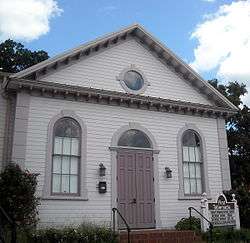William Saunders Crowdy
William Saunders Crowdy (August 11, 1847 – August 4, 1908) was an American soldier, preacher, entrepreneur, theologian, and pastor. As one of the earliest Hebrew Israelites in the United States, he established the Church of God and Saints of Christ in 1896 after he claimed to have had visions telling him "that Blacks were descendants of the twelve lost tribes of Israel."[1]
Early life
In 1847, William Saunders Crowdy was born into slavery at the Chilsy Hills Farm, a plantation in Charlotte Hall, Maryland.[2] His father was Basil Crowdy, a deeply religious man who oversaw the drying of clay for the plantation's brick kiln. His mother, Sarah Ann, was a cook, which often got her access to the "big house" despite her status as a slave.[3]
Crowdy was originally called "Wilson" by his overseer. Crowdy was born in a one-room slave cabin near the Patuxent River in the middle of a violent nighttime thunderstorm. Crowdy lived his early life in bondage working first by milking the plantation owner's cows. As he grew older he was assigned by the slave overseer to tend the plantation's melon patch, and then to work as a stable boy and tobacco drier.
Life was hard on a 19th-century plantation and the cruel overseer on Crowdy's plantation punished the slaves brutally. Despite it being illegal for slaves to read, Crowdy was a religious and caring man from a young age and learned the Hebrew prophets, especially Elijah. According to oral history Crowdy was beaten by the slavemaster at age 7 for taking too much cornpone from the ration cook to feed his sister. He spent the night locked in a barn for punishment but prayed to Moses to be released from bondage of his captors. Ten years to the day later, in 1863, at age 17, Crowdy escaped from his master after an argument.[4]
Crowdy shed the name Wilson, regarding it as a slave name,, and became William, which he then used to enlist at the nearest Union army recruiting station. He immediately took a job as quartermaster's cook. He joined the United States Colored Troops 19th Regiment of Maryland along with his half-brother Daniel[5][6]
Military career
Crowdy's unit was raised at Benedict, Maryland on December 19, 1863 when the United States Government offered compensation to his enslavers for his freedom to fight. During the Civil War the 19th Regiment USCT fought at the Battle of the Wilderness in 1864. Crowdy served as a laborer and supply storesman, and participated in the capture of a confederate flour wagon being smuggled into Petersburg, Virginia during the siege of Richmond. Crowdy remained in the Army after the war to become a Buffalo Soldier. He was promoted to quartermaster sergeant in the 5th Cavalry in 1867, receiving his discharge in 1872 . He later became a cook on the Santa Fe railroad.
Religious life

Crowdy settled in Guthrie, Oklahoma after his retirement from the railroad.
Crowdy claimed to have had several visions in which he was told "that Blacks were descendants of the ten lost tribes of Israel."[1] He proceeded to create the Church of God and Saints of Christ and is regarded as a founder of the Black Hebrew Israelite movement.[7]
He started preaching in Guthrie, and then set up Tabernacles in Emporia and Lawrence, Kansas in 1896. In these early days he was arrested 22 times. After setting up another Tabernacle in Topeka, he spread his creed in Sedalia, Missouri, Chicago, and several cities in New York, establishing an Elder-in-Charge in each city before moving to the next.
In 1903, he bought 40 acres (160,000 m2) of land in Suffolk, Virginia, calling it "Canaan Land". More land was subsequently purchased by Bishop William H. Plummer and this is now the international headquarters of the denomination. In 1905 he sent missionaries to South Africa and by 1906 he declared Chief Joseph W. Crowdy, Bishop William H. Plummer, and Elder Calvin S. Skinner as future leaders of his congregation.
Death
William Saunders Crowdy died on August 4, 1908, in Newark, New Jersey and was buried in Newark, New Jersey. His body was later exhumed and buried in Belleville, Virginia.
References
- Bleich, J. David (Spring–Summer 1975). "Black Jews: A Halakhic Perspective". Tradition: A Journal of Orthodox Jewish Thought. 15 (1): 63. JSTOR 23258489.
Crowdy claimed to be the recipient of a series of revelations in which, among other things, he was told that Blacks were descendants of the ten lost tribes of Israel.
- Elly M. Wynia, The Church of God and Saints of Christ: A History of the Black Jews Taylor and Francis Press, p. 19
- Beersheba C. Walker. The Life and Works of William S. Crowdy, E.J.P. Walker Press, 1955
- Gallagher, Eugene V.; Ashcraft, W. Michael (2006). Introduction to New and Alternative Religions in America. 5. Greenwood. p. 62.
- Civil War Regiment Records, National Park Service, Retrieved July 6, 2007
- "Soldier Demographic Information: Daniel Crowdy". College of Southern Maryland. 2006. Retrieved 2007-12-15.
- Rubel, Nora L. (2009). "'Chased Out of Palestine': Prophet Cherry's Church of God and Early Black Judaisms in the United States". In Curtis IV, Edward E.; Sigler, Danielle Brune (eds.). The New Black Gods: Arthur Huff Fauset and the Study of African American Religions. Indiana University Press. p. 57. ISBN 9780253004086.
In 1893, Crowdy had a vision that resulted in the establishment of the Church of God and Saints in Christ.